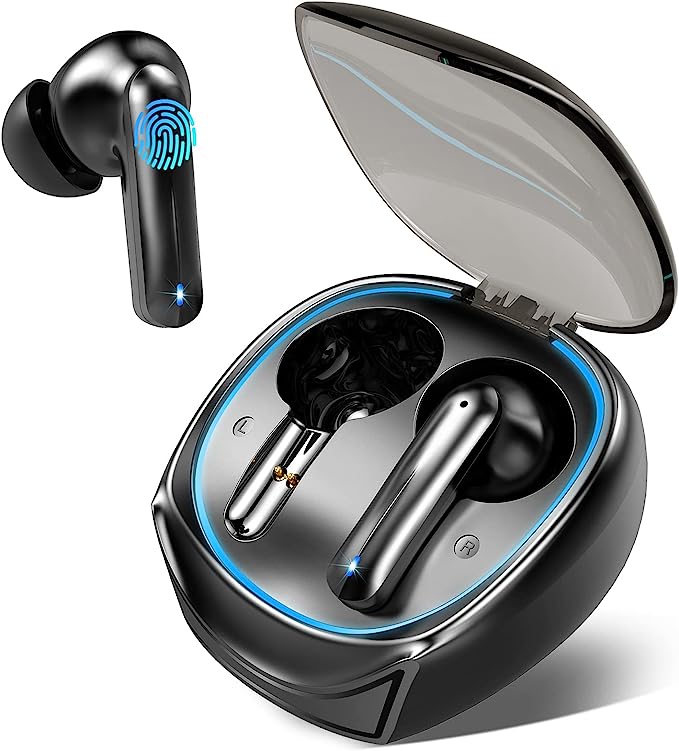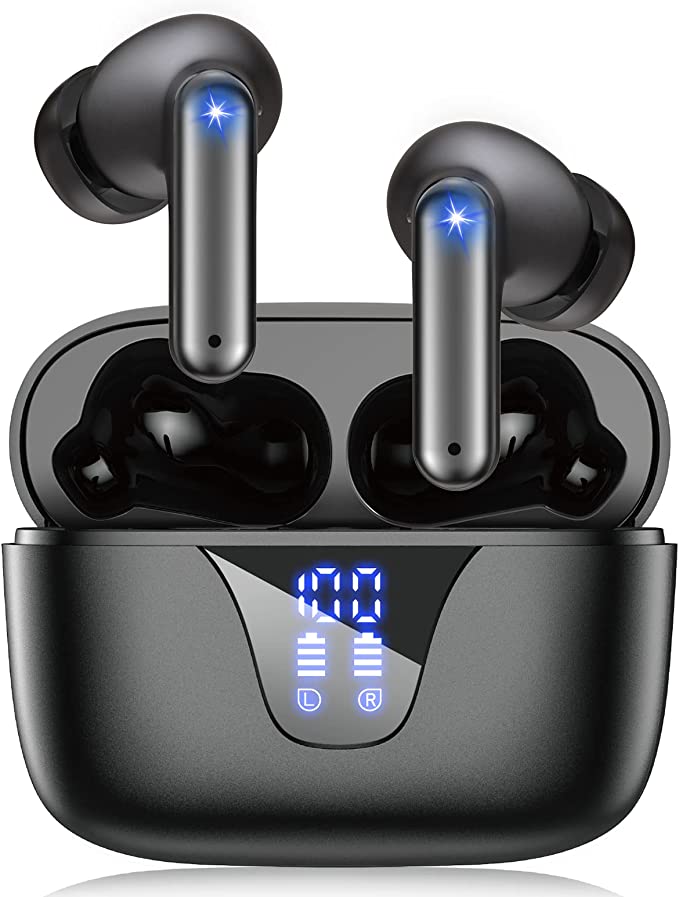Take a moment and listen. Not just to the world around you, but to the soundtrack of modern life. It’s the podcast accompanying your commute, the playlist powering your workout, the focused calm during a busy workday, or the clear voice of a loved one on a call – often delivered wirelessly, seamlessly, almost magically, right into your ears. We’ve grown accustomed to this cord-free convenience, but have you ever paused to wonder about the intricate dance of technology happening within those tiny earbuds?
Let’s pull back the curtain. While high-end audio gear often hogs the spotlight, fascinating science and engineering are also packed into accessible devices that millions use daily. We can explore this hidden world by looking closely at a common example, like the Smoonigh H68 wireless earbuds described in their product information. This isn’t about crowning a champion, but about appreciating the ingenuity that makes our wireless world hum. What exactly are Bluetooth 5.3, ENC, IP7, and those battery hour claims all about? Let’s decode the specs and understand the science making the silent symphony possible.

The Unseen Tether: Bluetooth 5.3’s Dance of Data
The very foundation of any wireless earbud experience is Bluetooth. Think of it not just as a feature, but as a sophisticated, personal radio communication system operating silently around us. Born from a desire to eliminate the tangle of cables connecting our devices, Bluetooth has evolved significantly since its early days. The Smoonigh H68 earbuds, according to their specifications, utilize Bluetooth 5.3.
But what does “5.3” actually mean for you? While each iteration brings various technical refinements, Bluetooth 5.x versions generally focus on improving upon their predecessors in key areas relevant to audio:
* Stability: Like having a clearer, less interference-prone radio channel between your phone and earbuds. This translates to fewer annoying dropouts or stutters, especially in crowded wireless environments. Bluetooth 5.3 includes features designed to make connections more robust and less susceptible to interference.
* Efficiency: Smarter power usage. Bluetooth 5.3 aims to sip battery power more judiciously, helping both your phone and your earbuds last longer between charges.
* Connection Management: While the standard itself offers advanced capabilities (like potentially connecting to multiple devices, a feature not explicitly claimed or confirmed for the H68 based on available info), a core benefit remains faster and more reliable initial pairing.
The H68 description highlights features that leverage this foundation. It mentions support for standard audio profiles (A2DP for music, HFP/HSP for calls, AVRCP for control), ensuring broad compatibility. It also points to a Hall Switch in the charging case. This isn’t magic, but clever engineering: a tiny magnetic sensor detects when you open the lid, triggering the earbuds to power on and automatically attempt to reconnect to the last paired device. It’s a small touch that removes a step, making the experience feel that much more seamless – that satisfying ‘click-and-connect’ moment. While the full potential of Bluetooth 5.3 is vast, for earbuds like the H68, the focus seems to be on delivering that core promise: a stable, fuss-free connection for your everyday audio needs.

Sound Waves & Silent Whispers: Decoding Audio and Call Clarity
Once connected, what about the sound itself? The H68 product details mention “Hi-Fi Stereo Sound” and “Deep Bass.” These are somewhat subjective marketing terms, but they point towards the goals of the internal audio drivers – the tiny speakers within each earbud. “Hi-Fi” (High Fidelity) suggests an aim for accurate sound reproduction across a wide range of frequencies, while “Deep Bass” indicates an emphasis on reproducing low-frequency sounds powerfully. The actual experience, of course, depends heavily on the quality of these drivers and the tuning.
However, a more specific and technically defined feature highlighted is Environmental Noise Cancellation (ENC), explicitly linked to the four built-in microphones (two per earbud). This is where things get interesting, and it’s crucial to understand what ENC is and isn’t.
Think about making a phone call from a busy street or a noisy cafe. The challenge isn’t just hearing the other person; it’s ensuring they can hear you clearly above the din. This is where ENC comes in. It’s designed primarily to improve your outgoing voice quality during calls.
How does it work? Imagine those four microphones acting like a team of listeners. Some are positioned to best capture your voice speaking nearby. Others pick up the ambient sounds surrounding you – the traffic, the chatter, the wind. Sophisticated algorithms (the ‘brain’ of the system) then analyze these signals. They work to identify and isolate your voice pattern while actively suppressing or reducing the volume of those unwanted background noises. It’s a bit like the “cocktail party effect” – our brain’s ability to focus on one conversation amidst many – but implemented electronically for your phone call.
Crucially, ENC is NOT the same as Active Noise Cancellation (ANC). ANC technology is designed for the listener’s immersion. It uses microphones to listen to the outside world and then generates anti-noise sound waves inside the earbud to cancel out ambient sounds before they reach your eardrum, creating a quieter listening environment for music or podcasts. ENC, as described for the H68, focuses outwards – cleaning up your microphone signal so the person you’re talking to has a better experience. So, while the H68 aims to make your calls clearer for others using its 4-mic ENC system, don’t expect it to silence the world around you like high-end ANC headphones might.

Marathon Power, Everyday Armor: Battery Life and IP7 Resilience
In our always-on world, battery life is paramount. The H68 specifications claim a potential total playtime of around 40 hours. This impressive figure breaks down into two parts: up to 8 hours of listening time from the earbuds themselves on a single charge, plus an additional 32 hours provided by the portable charging case.
Let’s translate that. Eight hours is enough to cover a full workday or a long flight. The extra 32 hours in the case mean you could potentially go for several days, or even a week of typical usage (a couple of hours per day), without needing to find a wall socket for the case itself. It grants a certain freedom from ‘battery anxiety’. This longevity is enabled by efficient components (like Bluetooth 5.3) and the energy density of modern Lithium Polymer (Li-Poly) batteries commonly used in these devices – they pack a lot of power into a small, lightweight package.
When the case eventually needs refueling, the H68 utilizes a USB-C port, the modern, reversible standard that’s becoming ubiquitous across devices, meaning one less type of cable to carry. Furthermore, it’s claimed to support fast charging, fully replenishing the case in about an hour, minimizing downtime.
Beyond power, there’s protection. The earbuds are rated IP7 waterproof. Let’s demystify this code. “IP” stands for Ingress Protection, a standard defined by the International Electrotechnical Commission (IEC). The first digit relates to solid particle protection (dust), often replaced by ‘X’ if not specifically tested. The second digit, ‘7’ in this case, relates to liquid protection. An IPx7 rating means the device is protected against the effects of temporary immersion in water under specific conditions: up to 1 meter deep for a maximum of 30 minutes (in fresh water).
What does this mean practically? It signifies that the H68 earbuds are designed to handle sweat during intense workouts, getting caught in a rain shower, or accidental splashes without failing. The description also mentions a “nano-coating,” likely a hydrophobic layer that helps water bead off. This makes them a reliable companion for active lifestyles. However, it’s important to understand the limits. IP7 doesn’t mean they’re suitable for swimming, showering (due to potential pressure and soap), or exposure to saltwater or other liquids. Think of it as a sturdy raincoat for your electronics, not scuba gear.

The Perfect Fit & Fingertip Commands: Ergonomics and Seamless Control
Technology is only useful if it’s comfortable and easy to use. Earbuds live in our ears, sometimes for hours, so ergonomics are critical. The H68 is described as having an ergonomic design and being lightweight (sources vary slightly, citing around 3.5g to 4g per earbud – incredibly light!). A good, secure fit isn’t just about preventing them from falling out; it also affects sound quality, particularly bass response and passive noise isolation (how well they physically block outside sound). To help achieve this personalized fit, they come with three different sizes (S, M, L) of silicone eartips. Finding the right size is key for both comfort and optimal audio performance.
Interaction is handled via Smart Touch Controls on the earbuds themselves. This allows for common actions like playing/pausing music, answering or ending calls, and potentially activating your phone’s voice assistant (like Siri, claimed accessible via a triple tap on the right bud) without needing to pull out your phone. It adds a layer of convenience, especially when on the move.
Finally, for those who enjoy mobile gaming or watching videos, the H68 description mentions a Low Latency Game Mode, claimed to reduce audio delay to 60 milliseconds (ms), activated via a triple tap on the left earbud. Why does this matter? Latency is the time lag between something happening on screen and you hearing the corresponding sound. High latency can be jarring – think of seeing an explosion before hearing the boom. A lower latency, like the claimed 60ms (generally considered good for wireless audio in casual gaming/video contexts), helps keep audio and visuals synchronized for a more immersive and responsive experience. This is likely achieved through optimizing the Bluetooth data transmission or perhaps using a specific audio codec when the mode is active.
Concluding Thoughts: Technology Woven into Life
Peeling back the layers of the Smoonigh H68, based on its product description, reveals a microcosm of modern personal technology. It’s not just a list of features, but a system where different technologies work in concert. The stability of Bluetooth 5.3 provides the reliable foundation. The 4-mic ENC system tackles the specific challenge of clear communication in noisy environments. Impressive battery longevity frees users from constant charging. IP7 resilience offers peace of mind during active use. And ergonomic design paired with intuitive controls ensures the technology integrates comfortably into daily routines.
While individual specifications tell part of the story, understanding the science and engineering behind them allows for a deeper appreciation. It shows how even accessible consumer electronics embody sophisticated solutions to common problems. Whether it’s the complex algorithms filtering noise for your calls, the precise radio wave management keeping your music flowing, or the material science warding off moisture, there’s a quiet ingenuity at play. The silent symphony of our wireless world is composed of countless such technological notes, working together to connect us, entertain us, and enhance the rhythm of our lives.




